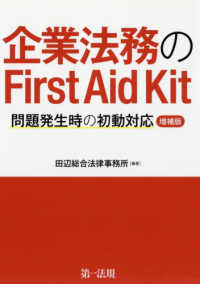- ホーム
- > 洋書
- > 英文書
- > Nature / Ecology
Full Description
Not since F. R. Harden Jones published his masterwork on fish migration in 1968 has a book so thoroughly demystified the subject. With stunning clarity, David Hallock Secor's Migration Ecology of Fishes finally penetrates the clandestine nature of marine fish migration. Secor explains how the four decades of research since Jones' classic have employed digital-age technologies-including electronic miniaturization, computing, microchemistry, ocean observing systems, and telecommunications-that render overt the previously hidden migration behaviors of fish. Emerging from the millions of observed, telemetered, simulated, and chemically traced movement paths is an appreciation of the individual fish. Members of the same populations may stay put, explore, delay, accelerate, evacuate, and change course as they conditionally respond to their marine existence. But rather than a morass of individual behaviors, Secor shows us that populations are collectively organized through partial migration, which causes groups of individuals to embark on very different migration pathways despite being members of the same population.
Case studies throughout the book emphasize how migration ecology confounds current fisheries management. Yet, as Secor explains, conservation frameworks that explicitly consider the influence of migration on yield, stability, and resilience outcomes have the potential to transform fisheries management. A synthetic treatment of all marine fish taxa (teleosts and elasmobranchs), this book employs explanatory frameworks from avian and systems ecology while arguing that migrations are emergent phenomena, structured through schooling, phenotypic plasticity, and other collective agencies. The book provides overviews of the following concepts: the comparative movement ecology of fishes and birds; the alignment of mating systems with larval dispersal; schooling and migration as adaptations to marine food webs; Natal homing; connectivity in populations and metapopulations; and, the contribution of migration ecology to population resilience.
Contents
Acknowledgments
1. Introduction
Classifying Migration
Book Organization
2. Bird and Fish Migration
Movement in Fluids
Analysis of Movements and Migration
Rules of Aggregation
Schooling and Flocking
Navigation Capacities
Summary
Segue
3. Mating Systems and Larval Dispersal
Mating Systems
Embryo and Larval Dispersal
Alignment of Larval Dispersal with Mating Systems
Selective Harvest during Spawning Migrations
Summary
Segue
4. Complex Life Cycles and Marine Food Webs
Marine Food Webs
Migrating among Size Spectra
Marine Ecosystem Patchiness, Transience, and Periodicity
Life Cycle Schedules
Schooling through Food Webs
The Storage Effect
Summary
Segue
5. Population Structure
Finding Their Way back Home
Life Cycle Closure
Open Life Cycles
Metapopulation Theory
Taking Stock of Population Thinking
Summary
Segue
6. Propagating Propensities
Conditional Migrations
Partial Migration Writ Narrow
Evolution of Partial Migration and Ecological Speciation
Partial Migration Writ Large
Summary
Segue
Recapitulation
7. Resilience
Resilience Theory
Resilience to Fishing and Climate Change
Collective Agencies and Biodiversity
Building Resilience into Populations
Summary
Bibliography
Index








